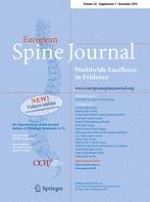01-11-2015 | Original Article
Lumbar spinal degenerative “microinstability”: hype or hope? Proposal of a new classification to detect it and to assess surgical treatment
Published in: European Spine Journal | Special Issue 7/2015
Login to get accessAbstract
Purpose
The stage of unstable dysfunction, also defined as “active discopathy” by Nguyen in 2015 and configuring the first phase of the degenerative cascade described by Kirkaldy-Willis, has specific pathoanatomical and clinical characteristics (low back pain) in the interested vertebral segment, without the presence of spondylolisthesis in flexion–extension radiography. This clinical condition has been defined as “microinstability” (MI). The term has currently not been recognized by the scientific community and is subject of debate for its diagnostic challenge. MI indicates a clinical condition in which the patient has a degeneration of the lumbar spine, causing low back pain, and radiological examinations do not show a spondylolisthesis.
Methods
We elaborated a clinical score test based on preoperative radiological examinations (static and dynamic X-Rays, CT and MRI) to detect and assess MI. Then, we enrolled 74 patients, all the levels from L1 to S1 were analysed, for a total amount of 370 retrospectively analysed levels. We excluded patients with degenerative scoliosis, as it is related to an advanced stage of degeneration. The test has been developed with the aim of furnishing quantitative data on the basis of the aforementioned radiological examinations and of elaborating a diagnosis and a treatment for the degenerative pathology in dysfunctional phase, responsible for low back pain.
Results
We performed a statistical analysis on the results obtained from the test in terms of significativity and predictive value with a 1-year follow-up, calculating the p value and the χ
2 value.
Conclusions
In patients with low back pain and negative dynamic X-Rays, an accurate analysis of the radiological exams (CT, MRI, X-Rays) allows to formulate a diagnosis of suspect MI with a good predictive value. This situation opens many clinical and medicolegal scenarios. The preliminary results seem to validate the test with a good predictive value, especially towards ASD, but they need further studies. On the basis of the results obtained, the test seems to allow a good classification of the dysfunctional phase of the degenerative cascade, identifying and classifying MI as a pathologic entity, defining its pathoanatomical and clinical relevance and elaborating a treatment algorithm.





